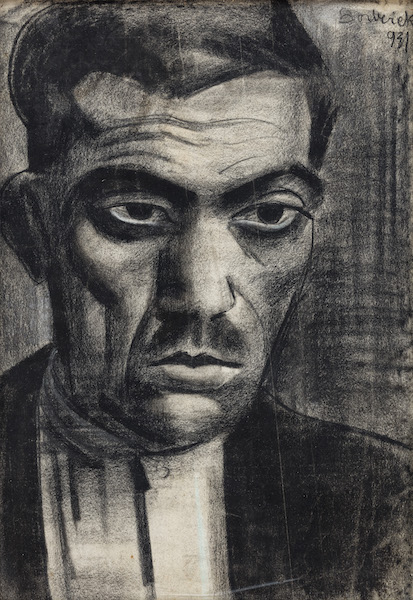Biography
From 1928, he was a student of János Vaszary and István Csók at the Academy of Fine Arts, studying painting. From 1931, he was Csók's teaching assistant for several years. He is not influenced by any of his masters, his paintings are characterized by an individual world of form, broad brushwork, a serene, bright color scale, definite dynamism, activity and generosity.
In 1932, he appeared for the first time in the Ernst Museum exhibition with his paintings and won the Székesfőváros painting prize that same year. In 1934-35, he received a scholarship to Rome. He continues his painting studies and attends the Academy of Fine Arts in Rome, where he also learns fresco painting from master Ferrazzi. The generous style of the fresco best corresponds to his artistic vision, which avoids minute details, seeks the essence and strives for the simplest possible forms. In Rome, he unexpectedly gives up painting and creates a big surprise with his concise sculptures reminiscent of Egyptian sculpture. It is striking that no attempt at plasticity can be detected in his paintings. It can be said that he is a born sculptor, and this sculpting instinct is always hidden in him. He becomes a mature sculptor without any prior studies. During his years in Rome, he was strongly influenced by the ideals of antiquity and learned from them. He becomes one of the most successful young sculptors of the 1930s.
At the artist colony in Szolnok, he belongs to Aba Novák's intellectual circle, and their friendship has always had a significant impact on his younger colleague. Here he modeled the Digger, the Head in Busby, and the Aba Novák bust, with which he won the Ferencz József Award of the Székesfőváros with unparalleled success. In his first works, stone is the preferred expressive material, and in later large tenders - winning the commission for the Madách monument and the Luther monument - he presented himself as a bronze sculptor with bravura skills.
The pear wood relief called Corncrumbs opens the line of his wood sculptures, and this is the starting point of the original relief style of the work. Next to stone, his favorite material will be wood. In addition to his paternal heritage, this attraction is confirmed by the fact that he works as a carpenter's assistant before college, obtains a certificate of completion, and even during the difficult college years, he earns his living with carpentry and covers his study expenses. He commemorates a difficult period of his life with his bas-relief entitled The Carpenter. His reliefs are either made of stone or wood, they create the effect of circular sculpture, to such an extent that he deepens, engraves and cuts the motif into the plane of the material.
His initial naturalism changes more and more strongly through the concise, generously composed portraits (Self portrait, Aba Novák portrait) and one-figure figures (Kubikos, Szentes) to multi-figure compositions and reliefs with complex structures (Cow Feeding, Corn Crumbling, etc.). The results of this era can be measured in the composition entitled Work, which depicts construction workers, the relief of Szent István in Pannonhalm, and the work entitled Hungarian Calvary.
In 1949-50, he lives with his family in Italy, the scene of his scholarship years. He arrived in the Union of South Africa in 1950, first settling in the more cultured Cape Town, then in the business center, the country's largest city, Johannesburg. The source of inspiration for his art is the natural wealth of the continent, the life and customs of the natives. He travels and discovers this vast and rich country with eager interest and his characteristic impatient enthusiasm. Among the tribes of Zululand, Lesotho, Transkei, he can bridge the contrast between the European white man and the reluctant black models with the charm of his personality. He constantly draws and studies the tribal costumes and customs, the beauties and anatomical features of the new ethnic group.
In addition to his spontaneous improvisations, in this era he is characterized by highly overheated expressive plastic expression (African drummer), the search for the African essence, movements and rhythms. With his increasingly stylized figures, he reaches non-figurative representation. He discovers new meanings in the sculptural materials found in his new home, and formulates his new experiences in them. In addition to ivory, stone, bronze and other metals, plastics and exotic woods, his interest increasingly turns to semi-precious stones native only to South Africa. (Malachite, sodalite, aragonite, rose quartz, patterned jasper, Transvalade, stichtite, etc.) His non-figurative, more abstract representations are created as a result of a long struggle.
His work is embedded in the aspirations of contemporary art (Gabo, Pevsner, Hepyforth, etc.). It goes from the monumental realism of naturalism to the expressive, constructive change of tone to the simplified, generous material-form harmony.
He took part in the gallery exhibition organized in 1970, where Hungarian artists living abroad presented themselves, and in the similar exhibition entitled Tribute to the Motherland, organized in December 1982. Many of his works are preserved in Hungarian and world-famous foreign public and private collections, many of his works decorate our public spaces and stand in foreign spaces. His work in the XX. lasting value of 19th century Hungarian art.

